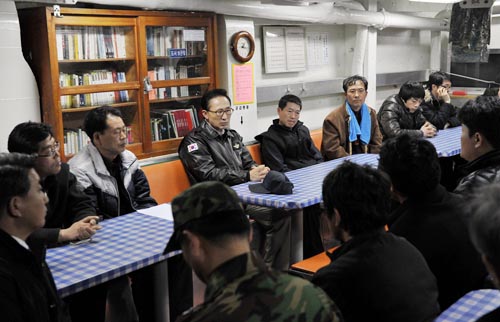For families of missing sailors, the longest day

President Lee Myung-bak yesterday talks with family members of missing sailors who have been staying on the Navy rescue vessel Gwangyang to watch search and rescue operations in the site. Lee made a visit yesterday to the site where the patrol ship Cheonan had sunk. [NEWSIS]
As the 69-hour survival window ticked to a close on Monday night, tempers began to fray among the families of the missing sailors on the Korean Navy corvette Cheonan.
The fear and tension had been building for days, ever since they learned the 1,200-ton patrol combat vessel had been torn in two by an unidentified explosion at 9:30 Friday night. Military specialists said any sailors who survived the blast had up to 69 hours - sometime between 7 and 8 on Monday night - in which they would be able to breathe if they had managed to seal off the compartment.
And the clock was running down.
It had been an exhausting day for the frantic families holed up at the Second Naval Fleet base in Pyeongtaek, Gyeonggi.
They had been buoyed that morning by news that rescue divers late Sunday night had found the rear half of the vessel, where the 46 missing men were believed to have been stationed when the ship sank in the frigid waters of the Yellow Sea.
At 9 a.m. Monday, as 66 relatives who had visited the blast scene on Saturday returned to the barracks and joined their waiting families gathered around a television set, a Defense Ministry briefing confirmed the discovery.
“Now they can find my brother, right?” said Lee Sun-hui, 30, the sister of missing Petty Officer Second Class Lee Sang-min, 21. Tears welled up in her eyes as she stroked a photograph of her brother’s face stored in her cell phone.
“The military can rescue Seon-ho now, can’t they?” asked Kim Seon-suk, 26, the sister of missing 20-year-old seaman Kim Seon-ho, who the Navy said had been exercising in the rear of the ship at the time of the blast. “He’s going to be promoted to Petty Officer Third Class and he’s so excited ... He will come back soon. He will definitely return alive because he was very healthy.”
But before military officials could continue the briefing, quarrels broke out. The seamen’s relatives pressed Navy officials about why no progress had been made in the rescue operation. The mother of missing Petty Officer First Class Seo Seung-won burst into tears.
Five hours later, the clock had reached 65 hours. The slightest problem ignited tempers. The relatives had heard the search and rescue operation had begun, but even television scenes of rescue squad members diving into the water brought them no comfort.
The families had lost trust in the military.
“How in the world are they going to rescue the personnel inside the ship if they’re moving so slowly?” demanded the mother of missing Chief Petty Officer Park Kyeong-su, who fought in an inter-Korean naval clash near Yeonpyeong Island off the west coast in 2002.
The uncle of Petty Officer First Class Sohn Su-min said, “Our children are trapped inside this sunken boat and they can’t move an inch. The military’s not only slow, it totally lacks sincerity.”
By 2:30 p.m., when a Navy officer rather than the Pyeongtaek fleet’s commander appeared at a briefing, the anger of the 150 families reached a crescendo. Family members scuffled with soldiers, and shouted for the commander. They rushed toward his headquarters, some 20 minutes away from the barracks; military personnel held them back.
The last news came at 5 p.m.
The Defense Ministry announced that rescue divers had reached the hull.
They knocked.
There was no response.
By Park Sung-woo, Jeong Seon-eon [smartpower@joongang.co.kr]










with the Korea JoongAng Daily
To write comments, please log in to one of the accounts.
Standards Board Policy (0/250자)